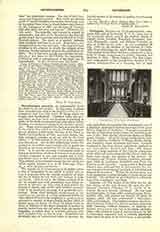

Covington, Diocese of (COVINGTONENSIS), Comprises that part of Kentucky, U.S.A., lying east of the Kentucky River, and of the western limits of Carroll, Owen, Franklin, Woodford, Jessamine, Garrard, Rockcastle, Laurel, and Whitley Counties, an area of 17,286 square miles. It was established July 29, 1853, by the division of the Diocese of Louisville, then embracing the whole State of Kentucky. This portion of the State had been ministered to by a body of clergy conspicuous for ability, learning, and devotion to duty. White Sulphur, the first organized congregation in this jurisdiction, rejoiced in the zealous administration of a Kenrick, who in later years graced the metropolitan See of Baltimore, and of a Reynolds, destined to become successor of the great Bishop England of Charleston. Lexington was growing into an important parish under the watchful guidance of Rev. John McGill, afterwards Bishop of Richmond, Virginia. All of the clergy manifested in their lives the glorious traditions of Flaget, Badin, David, and Nerinckx, whose successors they were. Catholic immigration has been almost exclusively confined to two nationalities: German and Irish. The former compose a large majority of the Catholic population of the cities and towns along the Ohio River, while the latter have sought the interior of the diocese. In Covington and Newport German Catholics predominate, while in Lexington, Frankfort, and Paris, the Irish are in the majority. Lying south of Mason and Dixon’s Line, although rich in raw material, the diocese has been handicapped by a lack of industrial and mineral development. Within its confines there is a total population of about 900,000, of whom 54,423 are Catholic. The attitude of non-Catholics is uniformly respectful, considerate, and kind.
BISHOPS.—(I) The choice of the Holy See for the first bishop of the new diocese fell upon the Rev. GEORGE ALOYSIUS CARRELL, S.J., rector of St. Francis Xavier’s Church, Cincinnati. He was born in Philadelphia, June 13, 1803, ordained priest December 20, 1827, and entered the Society of Jesus August 19, 1835. He was consecrated November 1, 1853, at Cincinnati. The burden resting on the shoulders of the new bishop of a diocese sparsely settled by 8000 Catholics, without influence or material resources, was a heavy one; but at his death (September 25, 1868), after fourteen years of zealous labors, he left it thoroughly organized with a Catholic population three times as great as he found there, a self-sacrificing clergy, a devoted people, and many educational and eleemosynary institutions.
The second bishop, AUGUSTUS MARIE TOEBBE, was born January 15, 1829, at Meppen, Hanover, Germany, and ordained priest September 14, 1854, at Cincinnati. He was consecrated January 9, 1870, and died May 2, 1884. He contributed largely to the increase of the parishes of the diocese and the growth of Catholicism.
CAMILLUS PAUL MAES, his successor, was born in Belgium, March 13, 1846, studied at the American College, Louvain, for the Diocese of Detroit, where he was chancellor when appointed to the See of Covington. He was consecrated January 25, 1885, and soon cleared off a diocesan debt of $150,000. He next undertook to replace the old cathedral, rapidly tottering to decay, with a magnificent Gothic pile in the most prominent part of the city. Bishop Maes also found time to care for the remote population dwelling in the mountainous parts of the diocese. Few people of the diocese were blessed with an abundance of wealth. James Walsh, a conspicuous benefactor, made possible the first free parochial school, and later enabled Bishop Maes to begin the erection of the cathedral. His son, Nicholas Walsh, followed generously in the footsteps of his father. Mrs. Mary Howard Preston, a zealous convert, gave the necessary funds to start the great work of the missions to non-Catholics in Eastern Kentucky.
STATISTICS.—The Catholic population (1908) is 54,423 (10,162 families). The clergy number 77 (68 secular, 9 regular). There are 74 churches, 38 stations, and 9 chapels; 3 orphan asylums (204 inmates); 2 hospitals (2962 patients); 2 homes for aged poor (351 inmates); 7 female academies (1491 pupils); 37 parochial schools (7782 pupils, of these 3744 are in Covington).
The religious communities in the diocese include: Men—Benedictine Fathers, five charges, and the Marist Brothers. Women Sisters of St. Benedict, Sisters of Charity, Sisters of St. Francis, Sisters of the Poor, Sisters of the Good Shepherd, Sisters of Notre Dame, Sisters of Providence, Loretto Sisters, Visitation Nuns.

